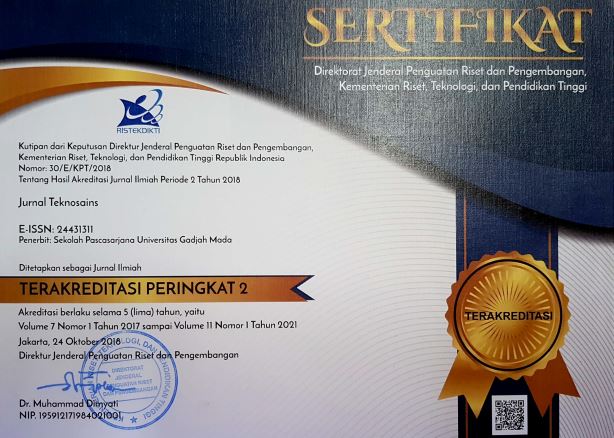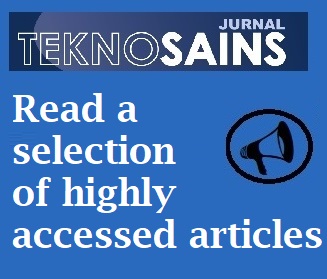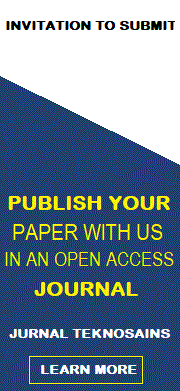Pencucian material magnetik pasir besi lansilowo menggunakan larutan asam klorida
Ricka Prasdiantika(1*), Susanto Susanto(2)
(1) Universitas Pandanaran
(2) Politeknik Negeri Malang
(*) Corresponding Author
Abstract
Iron sand was widely used in various fields such as in the manufacturing of magnets, cement, and steel. Iron sand has the main composition of iron oxide and several impurities of oxides. To remove these impurities, iron sand needs to be washed with acidic solution such as HCl solution. This study aims to minimize impurities in the magnetic material of Lansilowo iron sand. Iron sand was prepared using an external magnet to obtain magnetic material. The magnetic material was washed using distilled water and 0.5 M HCl solution. The drying process was carried out at 80oC for 24 hours. Magnetic material was crushed, weighed, and characterized. Material characterization was carried out using X-Ray Fluorescence (XRF), Fourier Transform Infrared (FT-IR) Spectrophotometer, and X-Ray Diffractometer (XRD). The Characterization results showed that washing of magnetic material using H2O-HCl 0.5 M was able to increase the percentage of Fe element composition in Lansilowo iron sand. The iron oxide contained in Lansilowo Iron Sand remains magnetite. The washing the iron sand magnetic material using 0.5 M HCl solution succeeded in removing impurities such as Mg, Pr, K, Cl, P, S, Co, Ce, and Sn as well as reducing the percentage of the Si and Al elements.The washing magnetic material using 0.5 M H2O-HCl produced higher XRD intensities than those washed with H2O. The washing magnetic material with 0.5 M H2O-HCl was result particle size of 37,70 ± 4,62 nm and crystallinity of 53.12%.
Keywords
Full Text:
PDFReferences
Afza, E. (2011). Pembuatan Magnet Permanent Ba-Hexa Ferrite dengan Metode Koopresipitasi dan Karakterisasinya. Skripsi, Universitas Sumatera Utara Medan.
Amal, M. I. (2008). Penambahan Pasir Besi untuk Pembuatan Baja Butir Halus dengan Pemaduan Mekanik dan Pengerolan Panas, Tesis. Pasca Sarjana Fakultas Matematika dan Ilmu Pengetahuan Alam, Universitas Indonesia.
Ansori, C. (2013). Mengoptimalkan Perolehan Mineral Magnetik Pada Proses Separasi Magnetik Pasir Besi Pantai Selatan Kabupaten Kebumen Jawa Tengah. Jurnal Teknologi Mineral dan Batubara, 9(3):145–156.
Cornell, R. M. and Schwertmann, U. (2003)The Iron Oxides : Structure, Properties, Reaction, Occurences and Uses. 2nd Ed, Weinheim: Willey-VCH GmbH and Co. KGaA.
Fahmiati, Nuryono, N., and Suyanta, S. (2017). Characteristics of Iron Sand Magnetic Material from Bugel Beach, Kulon Progo, Yogyakarta. IOP Conference Series: Materials Science and Engineering, 172:12020. DOI: 10.1088/1757-899X/172/1/012020.
Jal, P. K. K., Sudarshan, M., Saha, A., Patel, S., and Mishra, B. K. K. (2004). Synthesis and Characterization of Nanosilica Prepared by Precipitation Method. Colloids and Surfaces A: Physicochemical and Engineering Aspects, Elsevier, 240(1):173–178. DOI: 10.1016/j.colsurfa.2004.03.021.
Jitianu, A., Raileanu, M., Crisan, M., Predoi, M., Zaharescu, D., Jitianu, L., and Stanciu, M. (2006). Fe3O4–SiO2 Nanocomposites Obtained via Alkoxide and Colloidal Route. Journal of Sol-Gel Science and Technology, 40(2–3):317–323.
Komatina, M. and Gudenau, H. W. (2004). The Sticking Problem During Direct Reduction of Fine Iron Ore in The Fluidized Bed. Metalurgija, 10(4):309–328.
Kumari, N., Ari, V., Konar, J., and Bhagat, R. P. (2010). Beneficiation Of Iron Ore Slimes from Karnataka Through Dispersion And Selective Flocculation.in Proceedings of the XI International Seminar on Mineral Processing Technology: 564–571.
Lutfi (2012). Penggunaan Pasir Besi Sebagai Pengganti Semen Terhadap Kuat Tekan Dan Kuat Tarik Belah Beton. Media Bina Ilmiah Mataram, 6(2):24–28.
Mufit, F., Amir, H., Fadhilah, F., and Bijaksana, S. (2013). Kaitan Sifat Magnetik Dengan Tingkat Kehitaman (Darkness) Pasir Besi Di Pantai Masang Sumatera Barat. Eksakta, 2(14):70–75.
Pari, G. (2000). Pembuatan Arang Aktif Dari Batubara. Jurnal Penelitian Hasil Hutan, 17(4):220–230.
Petcharoen, K. and Sirivat, A. (2012). Synthesis and Characterization of Magnetite Nanoparticles via the Chemical Co-Precipitation Method. Materials Science and Engineering: B, 177(5):421–427. DOI: 10.1016/j.mseb.2012.01.003.
Prasdiantika, R. and Susanto, S. (2016). Preparasi dan Penentuan Jenis Oksida Besi Pada Material Magnetik Pasir Besi Lansilowo. Jurnal Teknosains, Universitas Gadjah Mada, 6(1):7-15. DOI: 10.22146/teknosains.11385.
Rahmawati, R. and Handayani, N. (2013). Handayani. 2013. Fabrikasi Ferrogel Berbahan Dasar Nanopartikel Magnetit (Fe3O4) Dari Hasil Sintesis Pasir Besi Pantai Utara Jawa Dan Sifat Magneto-Elastisitasnya. Jurnal Neutrino, 5(2):95–104.
Saman, N., Johari, K., and Mat, H. (2014). Adsorption Characteristics of Sulfur-Functionalized Silica Microspheres with Respect to the Removal of Hg(II) from Aqueous Solutions. Industrial & Engineering Chemistry Research, American Chemical Society,53(3):1225–1233. DOI: 10.1021/ie402824r.
Setiawati, L. D., Rahman, T. P., Nugroho, D. W., Nofrizal, N., Ikono, R., Suryandaru, S., Yuswono, Y., Siswanto, S., and Rochman, N. T. (2013). Ekstraksi Titanium Dioksida (TiO2) Dari Pasir Besi Dengan Metode Hidrometalurgi.in Prosiding Semirata FMIPA Universitas Lampung: 465–468.
Wijaya, K., Sugiharto, E., Mudasir, M., Tahir, I., and Liawati, I. (2010). Synthesis Of Iron Oxide-Montmorillonite Composite And Study Of Its Structural Stability Againts Sulfuric Acid. Indonesian Journal of Chemistry, 4. DOI: 10.22146/ijc.21871.
Wu, S., Sun, A., Zhai, F., Wang, J., Xu, W., Zhang, Q., and Volinsky, A. A. (2011). Fe3O4 Magnetic Nanoparticles Synthesis from Tailings by Ultrasonic Chemical Co-Precipitation. Materials Letters, 65(12):1882–1884. DOI: 10.1016/j.matlet.2011.03.065.
Yamaura, M., Camilo, R. L., Sampaio, L. C., Macêdo, M. A., Nakamura, M., and Toma, H. E. (2004). Preparation and Characterization of (3-Aminopropyl)Triethoxysilane-Coated Magnetite Nanoparticles. Journal of Magnetism and Magnetic Materials, 279(2):210–217. DOI: 10.1016/j.jmmm.2004.01.094.
Yu, L., Yin, Y., Mayers, B., and Xia, Y. (2002). Modifying the Surface Properties of Superparamagnetic Iron Oxide Nanoparticles through A Sol-Gel Approach. Nano Letters, 2:183–186. DOI: 10.1021/nl015681q.
Yulianto, A. (2007). Fasa Oksida Besi Untuk Sintesis Serbuk Magnet Ferit. Jurnal Sains Materi Indonesia, 8(3):39–41.
Zulfalina, Z. and Manaf, A. (2004). Identifikasi Senyawa Mineral Dan Ekstraksi Titanium Dioksida Dari Pasir Mineral. Jurnal Sains Materi Indonesia, 5(2):46–50.
Zulkifli, N. S. C., Ab Rahman, I., Mohamad, D., and Husein, A. (2013). A Green Sol–Gel Route for the Synthesis of Structurally Controlled Silica Particles from Rice Husk for Dental Composite Filler. Ceramics International, 39(4):4559–4567. DOI: 10.1016/j.ceramint.2012.11.052.
Article Metrics
Refbacks
- There are currently no refbacks.
Copyright (c) 2020 Ricka Prasdiantika, Susanto Susanto

This work is licensed under a Creative Commons Attribution-ShareAlike 4.0 International License.
Copyright © 2024 Jurnal Teknosains Submit an Article Tracking Your Submission
Editorial Policies Publishing System Copyright Notice Site Map Journal History Visitor Statistics Abstracting & Indexing









